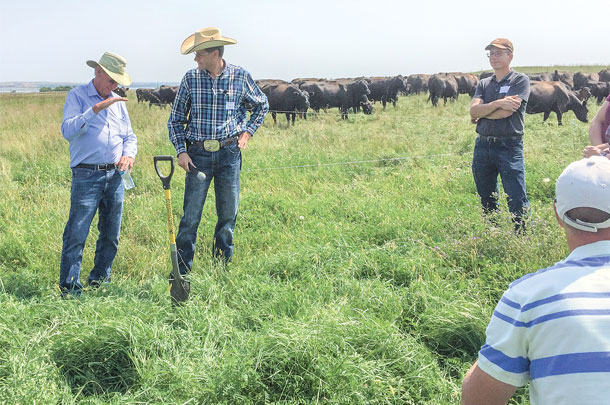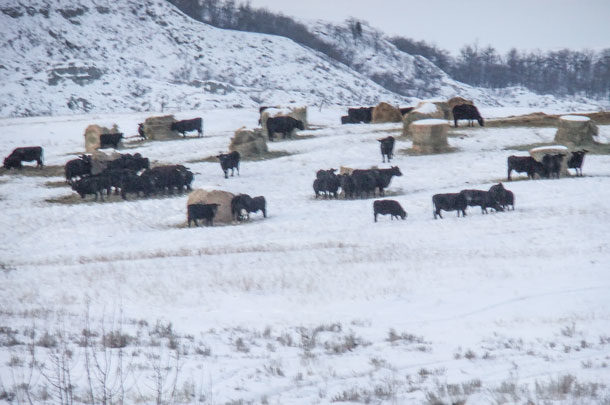It’s a great way to improve fertility of a field or pasture. Bale grazing can improve land that has been overgrazed or overcropped (with nothing put back into the soil) because it adds the missing nutrients.
Kevin Sedivec, North Dakota State University, was involved in a 3-year study with four producers in central North Dakota. County extension did the work, and the North Dakota Grazing Lands Coalition provided some of the funding.
“Our objective was to see if bale grazing actually increases forage production,” Sedivec said. “We also wanted to look at what was happening with nutrients from manure/urine, litter, etc. We focused on soil fertility and forage production and quality.”
The spot where each bale had been set was carefully assessed, for a certain distance around each bale. “The first year – the summer after the bales were eaten – there was a 50% increase in forage production 15 feet from the center of each bale. This is where manure and urine was deposited by cattle eating on the bale, but what was really interesting was that we almost doubled forage quality in terms of crude protein, compared with control areas. Control areas were in the same field, same soil type, same vegetation, but without the bale grazing,” he says.
“Where we didn’t bale graze, we had about 9.5% protein. Where we bale grazed, crude protein content in forage the following spring nearly doubled; it was almost 16% protein – all the way into July. With the increase in protein, the feed was higher quality, and also highly palatable; the cows seek it out,” says Sedivec.
“The second year after the bale grazing (about 16 months later), we saw increased production throughout the whole profile – from zero (center of where the bale had been) to 15 feet. It ranged from 130% of normal (a 30% increase) to as high as 180% (80% increase). We also saw an increase in phosphorus and potassium content of the grass for two years following bale grazing. The Northern Plains are generally short on phosphorus; it is the most limiting mineral in our native grasses,” he says.
Additional nutrients were deposited via fecal matter and urine, but the grass was picking it up. “Instead of going into the soil profile and deposited down-slope, the grass was increasing in quality. We did get a fourfold increase in nitrogen in the soil, however. For crop ground, you’d see a huge increase in nitrogen, which would reduce the need for fertilizer and reduce input costs. That was the big gain, for the soil,” says Sedivec.
Some producers worry about soil compaction around the bales from cattle being concentrated in those areas. “However, we saw no compaction. We looked for evidence of compaction at zero to 6, 6 to 12, 12 to 18, and 18 to 24 inches, and found none. This would probably hold true across the Northern Plains. Even if there is compaction at the time of grazing, the freeze-thaw cycles take it out. As long as you are not bale grazing into April – when grass is trying to grow and the frost has already come out – you won’t see compaction. If you bale graze later in the spring you don’t get the benefit of the freeze-thaw cycle because the ground has already thawed,” he says.
He’s not sure how this would work farther south where there isn’t much frost in winter to counteract compaction. There may also be variability in overall results with climate differences, but in general, the production, fertility and quality will increase.
“In our study, every rancher’s management was different. One supplemented his cows while they were bale grazing, and the other three did not. One pushed his cows harder, making them clean up the old bales before they went to new ones. Another rancher did not push his cows at all and ended up with too much litter. He actually lost production the first year after bale grazing because there was so much litter that the grass couldn’t grow up through it and production was cut in half.”
Yet because that litter held moisture, during the drought in 2017 (second growing season after bale grazing), that producer had the greatest increase in forage production. “The litter had broken down by then and was still holding moisture. He grew more grass in those areas than in other areas of the field,” says Sedivec. In subsequent years, litter is a big plus, but if there is too much the first year it can cut down production.
“The fourth rancher, Ken Miller, did it about right. He’s been bale grazing a long time. He grazes bales fairly hard, but leaves some litter. He gets increased production the first, second and third year afterward, whereas producers who leave too much litter see a decline in production the first year. You give up a year of production if you leave too much; it’s better to make the cows clean up more, yet each producer has different goals.”
After the bale grazing, there was an increase in organic carbon in the soil, but it takes more time to increase organic matter. “It takes 10,000 pounds of organic material in the soil to create 1 percent increase in organic matter, so it takes time,” says Sedivec. ![]()
PHOTO: Compaction is reduced or eliminated in the area surrounding the bale because of frost and moisture the ground receives. Photo provided by Ken Miller.
Heather Smith Thomas is a freelance writer based in Salmon, Idaho.
PRODUCER EXPERIENCE

Ken Miller grows crops and livestock in south-central North Dakota near Fort Rice. His management strategies and soil improvements led to his receiving the 2017 Leopold Conservation Award for North Dakota.
His goal has been to improve the soil. “The fields I’m bale grazing were poor cropland that we seeded back to a mixture of grasses 36 years ago. The problem when we seeded them was that the soil lacked nutrients, and there was a lot of bare ground,” he says. By strategically placing bales, he adds litter plus nutrients from manure and urine.
“In the study with the Extension Grasslands, they took clippings to measure forage production and soil tests to track how soil improves,” says Miller. “We marked where each bale was set – a metal peg underneath, to locate where they were. The first year of the study was fairly wet (spring of 2016), and there was about 1.9 times more production where we bale grazed than where we didn’t. The next year, production was about half because of the drought, but where we didn’t bale graze there was only about 19 percent.”
The next winter there was very little snow, but timely rains in spring. “Production where we bale grazed looked phenomenal. Grass was taller than the four-wheeler where we bale grazed three years earlier. It almost doubled production. Clippings were taken at zero, 5, 10 and 15 feet away from the bale center (four corners for each bale – 16 samples for each bale site) and the same spacing for the control area, along with soil tests. This is a way to improve land that has been overgrazed or overcropped with nothing put back into the soil. Bale grazing adds the missing nutrients. People say we are lacking in moisture, but we are also lacking nutrients,” Miller says. If there’s grass growing (from bale grazing), pasture can capture all the moisture, rather than having it run off.”
PHOTO: The litter from the bale has specific nutritive advantages to improve soil health and allow pastures to regenerate successfully. Photo provided by Ken Miller.









